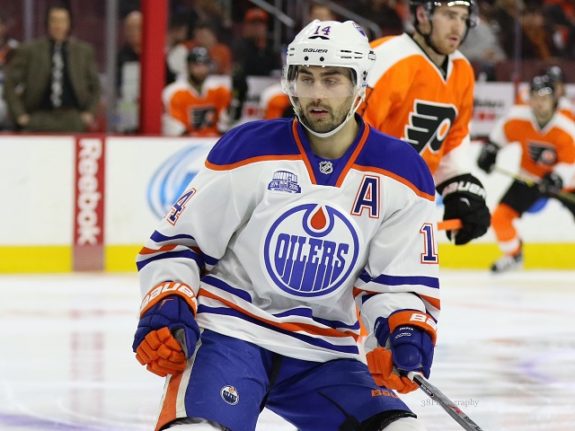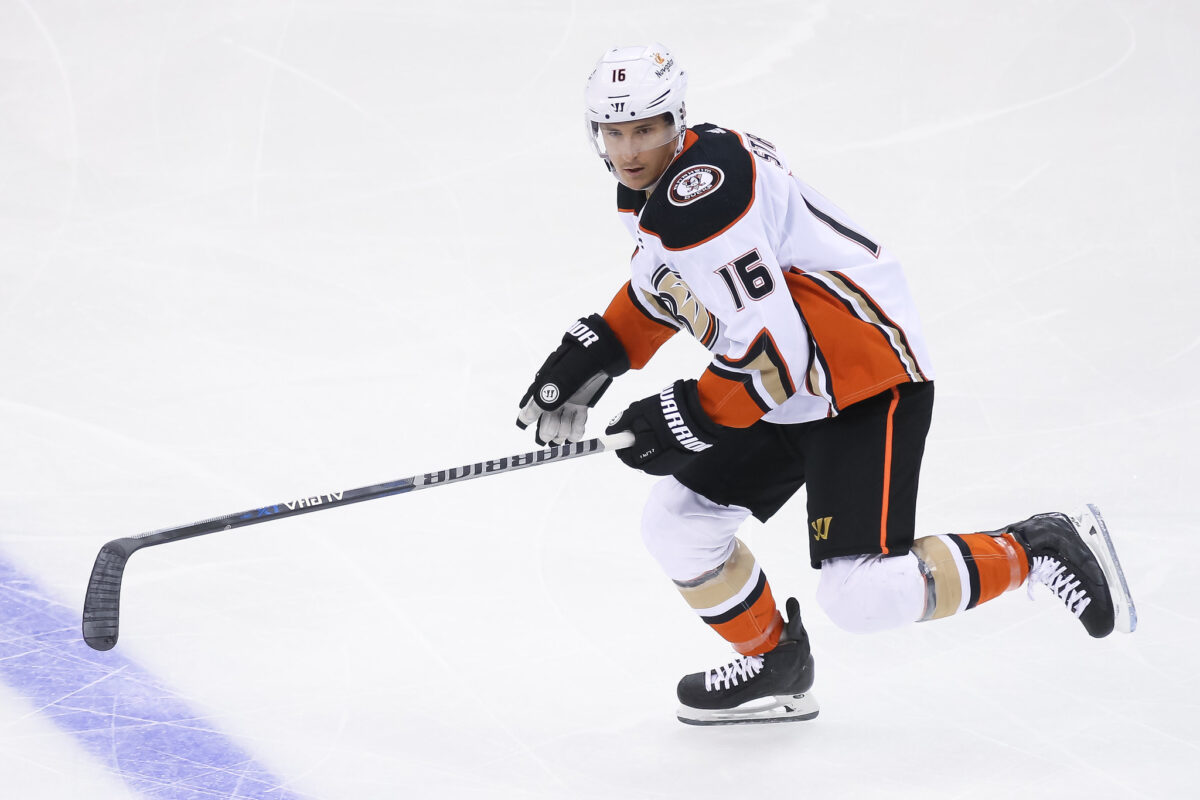The 2017 trade of Jordan Eberle by the Edmonton Oilers to the New York Islanders for Ryan Strome sent shockwaves throughout the hockey world. At the time, Eberle was a highly-skilled former 30-goal scorer who was coming off a respectable 20-goal, 50-point campaign in 2016-17. However, the playoffs proved to be one of the more lackluster debuts by a player of his caliber, due to a zero-goal and two-assist performance, as the Oilers were bounced in Game 7 of the second round to the Anaheim Ducks.
With two rising superstars in Connor McDavid and Leon Draisaitl, the Oilers needed some additional scoring punch to achieve playoff success. Therefore, the trade of their third-leading point scorer for an unproven forward with top-six potential was somewhat of a surprise (even with the playoff struggle), even though the Eberle trade rumors had been circulating for quite some time due to his six-year, $36 million contract.
Many discussions have been had over the years regarding the Taylor Hall for Adam Larsson trade, but the Eberle deal seems to often get overlooked. However, this trade also had significant implications that have continued to impact the Oilers and their inability to win a playoff series since.
The Eberle Trade and the Rationale Behind It
As discussed earlier, the Eberle trade rumors had begun circulating a couple of years prior, around the same time period that the Hall rumors began. This is relevant because, during this era of Oilers hockey, there was major discussion regarding a trade of either Hall or Eberle for a top-pairing defenseman. That ended up being the Hall for Larsson trade in the offseason following the 2015-16 season.
The results of this Hall trade are well-documented, including by The Hockey Writers’ Rob Soria, but many believed that the Oilers would hold on to Eberle following the Hall deal to provide McDavid or Draisaitl with some much-needed aid on the wing (McDavid and Drasaitl had 100 points and 77 points, respectively, in 2016-17).

However, the trade rumors continued to percolate into the 2016-17 season, and they amplified following the playoffs. Reports continued to circulate throughout this time that Eberle’s attitude, inconsistency, and one-dimensionality frustrated coaches and then-general manager Peter Chiarelli, as outlined by THW’s Jim Parsons at the time of the trade. This was further intensified by Eberle’s $6 million per year contract, and they’d end up shipping him to Long Island for Strome, a 24-year-old forward who was the fifth overall pick in 2011.
Strome had major potential to become a top-six forward and a significant contributor offensively who could play as both a centerman or winger. Of course, the major implication of this entire trade was the money, as Strome was under contract to a very cost-effective $2.5 million annually for two years.
Strome had achieved one 50-point season with the Islanders but was coming off a modest 30-point campaign in which he missed 13 games due to injury. It seemed as though the Oilers believed that he could sufficiently fill Eberle’s void by opening up some significant cap space to retain restricted free agents and potentially sign another solid defenseman. But that’s not how Strome’s time in Edmonton would end.
How the Eberle Trade Worked Out
The most important component of this trade is that the Islanders made the deal to provide offensive support for John Tavares at the time, as he and Eberle were teammates on Canada’s 2009 World Junior team. Yet, the Oilers basically decided to move in the opposite direction and remove a talented offensive piece to support Draisaitl and McDavid.
Eberle was a significant contributor for the Islanders alongside young, talented center Mathew Barzal, with 76 goals and 169 points in 272 games on Long Island. He was also a key piece in the Islanders’ playoff runs, including two trips to the Eastern Conference Final.
The Islanders have since moved on from Eberle, as they left him exposed for the Seattle Kraken at the expansion draft, where he was selected for their inaugural roster. But he remains one of the league’s underrated scorers, as he has 58 goals and 151 points in 239 games with the Kraken. McDavid and Drasaitl are two of the league’s elite scorers, but scoring depth on the wing has been an issue for the Oilers. And Eberle’s goal-scoring capability would still be quite useful alongside McDavid or Drasaitl.
But despite Eberle’s solid production, his trade is not even the most frustrating part of this entire ordeal. Strome never got a real opportunity to prove himself with the Oilers’ top-six. Former head coach Todd McLellan consistently had Strome as the third or fourth-line center or as a second-line winger on occasion due to injury. He seemingly never got any true chances to be a core piece on the team.
Related: Oilers With 100-Point Seasons
Strome wasn’t a world-beater in his time with the Oilers, but he was more than capable of being a key contributor and having significant involvement with the offense and on the second power-play unit. Chiarelli brought him in to be a potential young and economically efficient secondary scoring and playmaking option. It didn’t work out, and after just 14 goals and 36 points in 100 games with the Oilers, they traded him to the New York Rangers.
Ryan Strome Trade to the Rangers and Aftermath
As described above, Eberle performed quite well in both the regular season and playoffs on the Islanders’ top line alongside Barzal and Anders Lee. He was a key reason for the Islanders’ continued success, even after Tavares’ departure. And it’s clear the Islanders missed his goal-scoring and offensive production, as they finished 16 points out of a playoff spot.
As for Strome, following his struggles and, quite frankly, the Oilers’ mismanagement, they dealt him to the Rangers for career third-liner Ryan Spooner in Nov. 2018. He became a restricted free agent following the season, but this trade couldn’t really be considered a salary cap-clearing move because Spooner was making $4 million per season himself.
The shocking part of the trade was that Strome, who had been written off by many due to his Edmonton tenure, became a very respectable top-six forward on an up-and-coming Rangers squad. He was their consistent second-line center alongside Kaapo Kakko, Chris Kreider and even Artemi Panarin from time to time. In July 2022, he signed with the Anaheim Ducks. During his Rangers tenure, he compiled 195 points in 263 games, including 54 points in 74 games in 2021-22.

Spooner, on the other hand, lasted 25 games with the Oilers and had three points as a third-line center. He was a decent penalty killer before getting traded to the Vancouver Canucks during the 2018-19 season, where he was bought out. He now plays for Avtomobilist Yekaterinburg in the KHL, where he had 34 points in 45 games in 2021-22.
Clearly, Spooner was not the answer the Oilers were looking for offensively or defensively, especially at his price tag. And the trade brought back Sam Gagner, who had been a solid contributor for nearly seven seasons in Edmonton previously and had played up and down the Oilers’ lineup.
Gagner was definitely not the player he was during his original stint in Edmonton, as he split time between the minors and the NHL in 2018-19 and entailed a cap hit of $3.15 million annually. He played a total of 61 games over two seasons in the NHL (along with four games for the Bakersfield Condors in the minors), where they attempted to utilize him with a variety of different line combinations, which resulted in just 22 points and consistently lackluster defensive performance.
He was no longer able to be a constant contributor on the power play, was not involved with the penalty kill, and seemed to have a difficult time adapting to playing on the various Oiler lines and was eventually traded to the Detroit Red Wings in Feb. 2020.
Current and Future Implications of the Eberle Trade
This article has been quite critical of the Oilers’ decision-making, and it’s quite evident that the wide-held belief that the Islanders won the trade at the time remains true today. Even the acquisition of Andreas Athanasiou, who the Oilers picked up when they traded Gagner to the Red Wings, didn’t work out as hoped. Athanasiou played in nine games for the Oilers, totaling just two points. He signed with the Los Angeles Kings for 2020-21, where he had 10 goals and 23 points in 47 games — a 40-point pace over 82 games. He then signed with the Chicago Blackhawks in July 2022.
Related: 5 Forgotten New York Islanders
Despite struggling with injuries in recent seasons, Athanasiou can still generate and finish scoring chances due to his large frame, power finishing, and high-risk, high-reward throwback style of play. Outside of Zach Hyman and Evander Kane, the Oilers don’t have a ton of scoring depth on the wing, especially as they move down their lineup. If Athanasiou were still on the roster and healthy, they’d benefit from someone being able to put up 40-45 points in a middle-six role as he is.
Offensively, Athanasiou would fit in well with Draisaitl and Ryan Nugent-Hopkins. That’s because of his ability to battle in the corners and dig out loose pucks, get to the front of the net, and create and finish chances with a solid shot and passing capabilities. Of course, that’s assuming Athanasiou could stay healthy, which had been a problem in 2021-22.
In all, the Eberle trade was complete mismanagement by Chiarelli and McLellan. They have never been able to recapture what they lost in Eberle. They mishandled the players they acquired and made head-scratching decisions with the players associated with this trade.
Current general manager Ken Holland tried to salvage something with Athanasiou. But even if that deal worked out, he would’ve never replicated what Eberle provided offensively. And the lack of scoring depth that was compounded with the trading of Eberle has persisted ever since.
